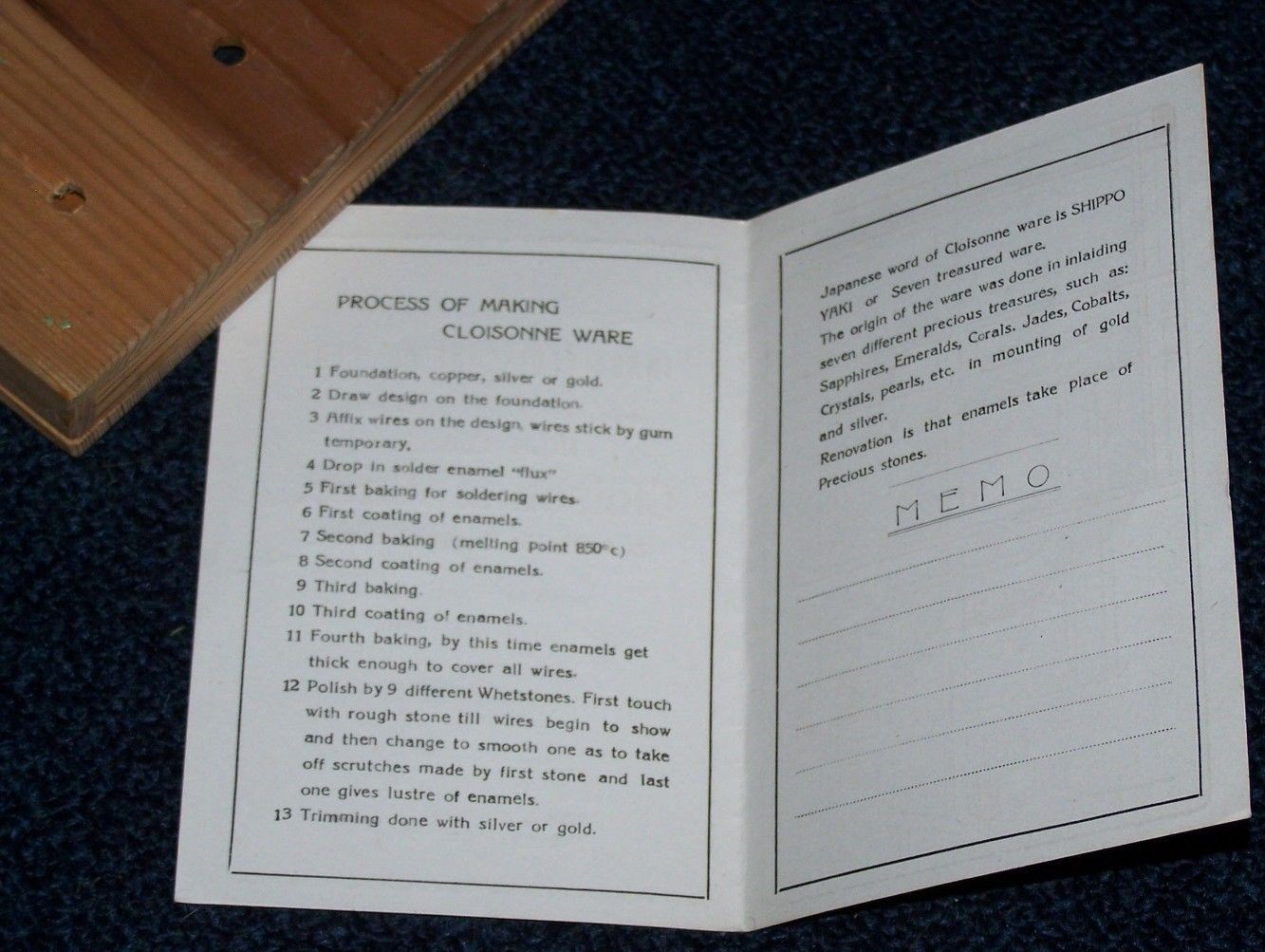A few months ago a small handful of what are likely antique
Japanese cloisonné beads was offered by U.K. eBay seller worth1010:
 |
| Japanese 15mm beads on left, contrasted with more recent 15mm Chinese cloisonne beads on right |
 |
| Close-up pictures make these beads appear the size of golf balls. The Chinese goldfish bead from the previous picture is shown atop a U.S. dime coin in an attempt to provide some sense of proportion. |
Over the years at the beadcollector.net forum various other
Japanese cloisonné beads have been discussed, including a set owned by Stefany
Tomalin that appear to be similar to those in the eBay sale.
 |
| Larger beads are 18-20mm, smaller are 12mm. Stefany's beads appear to have a better polish. |
Gregory Irvine, in his book Japanese Cloisonné Enamels (V&A publishing, copyright 2011)
shows an illustration on page 18 of an early enamel inro, ojime, and netsuke
set dated to 1800-50, in the collection of the Victoria & Albert Museum.
A similar ojime appears in this set from an online auction:
“In comparison to later work, these doro shippo pieces user lower fired enamels…with a more limited
opaque palette, generally of dull and subdued colors…often emphasizing deep
green, and incapable of polishing to a hard, mirror-like surface. … Because the
pieces were fired at a relatively low temperature and the enamels did not melt
well, they usually emerged from the kiln with a wavy enamel surface and severe
pitting, and thus often required grinding after each of the many firings needed
to complete a piece. … The enamels did not adhere well to the metal substrate
and had a coefficient of expansion that tended to leave cracks when fired;
therefore, closely-spaced wires were required over the entire surface to hold the
enamels properly in place and prevent cracking even when the design did not
warrant them.”
Most interestingly with regard to our subject, Schneider
goes on to relate:
“By the mid-1860s … Japanese wirework was quite fine and the
enamels, though dull and emphasizing a dark green ground, were well placed in
the cells rather than spilling over into adjacent areas – thus a very high
level of skill had already been achieved before the 1868 end of the Edo era and
the absorption of Western technical influence.
Three items whose quality exemplifies the precision and workmanship of
this period were purchased at the Paris 1867 exposition by the South Kensington
Museum, predecessor to London’s Victoria and Albert Museum. The three also exemplify the prevailing cloisonné
enamel decorative style of the period – minute, somewhat abstract flower
patterns and textile brocades done in small cells of purple, red, yellow, white,
and blue on a dark green ground. … In their forms, one a sake ewer, another a cylindrical
three-tier nested food box, and the third a string of ten ojime beads, all traditional Japanese items suitable for sale in
the domestic market…”
I wonder if the string of ten ojime resembles the other Japanese beads found in in the U.K. by Stefany Tomalin and worth1010 on eBay? The Victoria & Albert museum website lists their accession number, but states they're in storage and provides no picture. [Months later - I paid the V&A their fee to photograph these beads, the picture is now visible at the link. They are similar to the beads in Stefany's necklace shown above.]
In color plate Fig.8 he illustrates netsuke and ojime with
opaque enamels dated to the 19th-early 20th centuries, similar to the set quoted from Irvine's book above.
A further reference to cloisonné beads is on page 189:
“An early twentieth century Ando Japanese-language flier,
circa 1904, advertised rings, bracelets, hairpins, hair ornaments, combs,
hatpins, cuff links, buttons, buckles, pin, and beads, made to the customer’s
design, so there must have been demand in the domestic market and/or from
retailers for resale to foreigners, although few such pieces marked Ando
survive.”
For those interested, a quick flyover of Japanese cloisonne is provided by the Victoria & Albert Museum.
UPDATE: Some more examples of Japanese beads, plus a link to the Internet Archive for The Industries of Japan: Together with an Account of its Agriculture, Forestry, Arts and Commerce, from Travels and Researches Undertaking at the Cost of the Prussian Government, by Johann Justus Rein, published in New York by A.C. Armstrong and Son, 1889. Pages 492 onward contain a rare detailed account of the Japanese cloisonne manufacturing technique.
 |
| Ojime-style beads strung on inro cord, possibly as a belt or necklace. Intricate beads incorporated into a necklace with gold chain and red jade pendant (back of pendent view; front features a squirrel and peaches) |
UPDATE: U.K. eBay vendor buckinghamshire_antiques discovered two Japanese cloisonne plates that seem to be excellent illustrations of the 1870s style described above in the quote from Fredric Schneider.
Notice the small clouds forming a background pattern on the morning glory plate that appear to be identical, in both shape and arrangement, to the pink clouds on the turquoise ojime pictured above.
UPDATE: More stunning examples of cloisonne ojime from the collection of Frederick Chavez can be found at the beadcollector.net forum in two posts here. Click through and view these, they are not to be missed!
UPDATE: ParadeAntiquesBlog has a set of 6 pictures of a "c1860 Kaji Tsunekichi Style Japanese Cloisonne Vase." Note the arrangement of the little cloud motifs (between the two shiny reflections).
UPDATE: Another beadcollector.net thread, comparing doro shippo and 1868 Meiji cloisonne beads, with fabulous examples from the collection of Frederick Chavez.
UPDATE: Beads: The Journal of the Society of Bead Researchers accepted the article I wrote (with extensive assistance from Fredric Schneider) about the development of Japanese cloisonne beads.


































